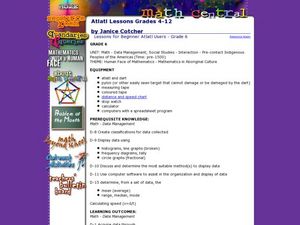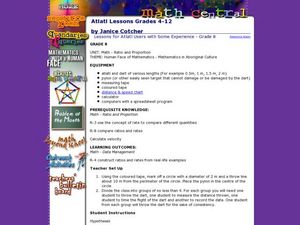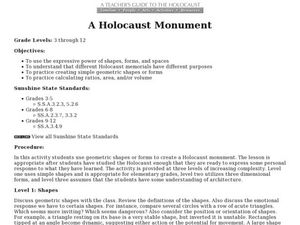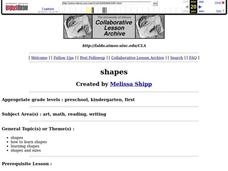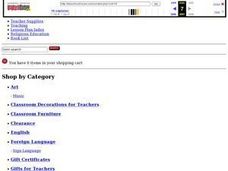Curated OER
Atlatl Lessons Grades 4-12: Lesson for Beginning Users of Atlatl
Sixth graders determine the mean, range median and mode of a set of numbers and display them. In this data lesson students form a set of data and use computer spreadsheet to display the information. They extend of the process by looking...
Curated OER
Let's Learn about Symmetry
Students explore symmetry in architecture. In this cross curriculum art and architecture lesson, students fold paper to illustrate symmetry and identify symmetrical and asymmetrical shapes. Students observe photographs or take a walk...
Curated OER
Handling Data: Representing Date - Online Version
Here is an online lesson plan on data representation. In it, learners access websites embedded in the plan which lead them through a variety of activities around data representation and statistics. The activities are quite good, and...
Curated OER
How Many?
In this counting to five worksheet, learners solve 8 problems in which a set of objects is counted and the correct number circled from five choices.
Curated OER
Shape Hokey Pokey
Students identify different shapes by using music. They use the shape in a song which follows the Hokey Pokey music. They participate in the song using different shapes.
Curated OER
Atlatl Lessons for Grade 8
Eighth graders explore the weapons of the Aboriginal people. In this eight grade math/science lesson, 8th graders collect and analyze data regarding the speed and distance of a dart thrown with an atlatl. Students choose the...
Curated OER
Cryptography Implementation
Young scholars explore cryptology. They write a research paper on cryptography. Using linear equations, students invent a code and write a secret message. Young scholars complete cryptography puzzles.
Curated OER
How Many?
In this counting worksheet, students solve 8 problems in which objects in a set are counted and the correct number circled from 5 choices. All sets will be between 6 and 10 objects.
Curated OER
Farm Animals Counting Worksheet
For this counting practice worksheet, students solve 4 problems that require them to count the number of animals indicated in the each of 4 boxes.
Curated OER
A Holocaust Monument
Students examine Holocaust memorials to discover expressive power of shapes, practice creating simple geometric shapes or forms, and practice calculating ratios, area, and/or volume.
Curated OER
The Coordinate Plane
Fifth graders use the attached worksheet, Where's My Location? - Directions, to play a game in which they plot points on a grid.
Curated OER
Information at a Glance - Using Tables in Mathematics
Young scholars create table to display GED Testing data located in paragraph provided by teacher, use information in table to create appropriate graph, and determine percentage difference between passing scores and failing scores.
Curated OER
A Holocaust Monument
Students create a Holocaust memorial. In this interdisciplinary lesson, students use geometric shapes or forms to create a Holocaust monument.
Curated OER
Earth Day Worksheet - Counting Twelve
In this Earth Day counting instructional activity, students practice counting to 12. They count the number of recycle bins and color the correct number at the bottom of the page. They choose from 10, 11, or 12.
Curated OER
Hamsters
Students read books, learn about the letter h, and eat apples all to learn about hamsters. In this hamsters lesson plan, students also use play dough to make hamsters.
Curated OER
Where is Triangle?
Students listen to songs to discover different shapes. They tape the shapes to their fingers and when they sing about that shape they are to show the shapes to each other.
Curated OER
The Shape of Me
Students tell about themselves, follow directions, learn shape recognition and are creative.
Curated OER
Graphing Inertia: An Oxymoron?
Eighth graders investigate Newton's Law of Inertia in order to create a context for the review of the use of different types of graphs. They practice gathering the data from an experiment and put it into the correct corresponding graph.
Curated OER
Tracking the Storm
Students discuss the different types of storms that can hit land. They locate specific coordinates on a plane grid. They discuss lonsgitude and latitude to plot the coordinates of a tropical storm. They practice finding coordinates...
Curated OER
Math: Christmas Count Down
Students use various tools to calculate the number of days before Christmas. Among the tools are number lines, calendars, and the Internet. Each day, a student visits a Christmas Countdown Website to report the days left. At the end of...
Curated OER
Make Your Own Shape Puzzles
Students create their own shape puzzles. They practice putting puzzle pieces together so they fit correctly. They classify and sort the different shapes as they finish the puzzle.
Curated OER
Shapes
Students discuss different shapes each day of the week. Students connect shapes they are learning to shapes they see in the real world.
Curated OER
What Comes From Corn
Students name and examine various items that are made from corn. Students compare ears of corn to Indian corn, and cook several items made from corn. Students create a popcorn picture and illustrate a book.
Curated OER
Sorting Lids
Students practice sorting lids in different ways so that each group determines a sorting pattern. They examine how to work in groups while sharing ideas. They establish group work relationships that become apparent to the teacher in this...


